
SIBERIAN MATHEMATICAL JOURNAL
Scope & Guideline
Unveiling Innovations in Mathematical Science
Introduction
Aims and Scopes
- Algebra and Group Theory:
Research in this area includes studies on the properties of finite groups, the structure of algebras, and the applications of group theory to various mathematical problems. - Functional Analysis and Operator Theory:
Papers often explore the properties of different types of operators, including boundedness, continuity, and spectral properties in various functional spaces. - Partial Differential Equations:
The journal publishes significant contributions to the theory and application of partial differential equations, focusing on existence, uniqueness, and stability of solutions. - Geometric Function Theory:
This area encompasses studies related to mappings, geometric structures, and their properties, particularly in relation to Carnot groups and other non-Euclidean spaces. - Inverse Problems and Control Theory:
The journal includes works that address inverse problems in various contexts, such as heat transfer and differential equations, alongside contributions to control theory. - Mathematical Physics:
Research often intersects with physical applications, exploring mathematical modeling in physics, including wave equations and fluid dynamics.
Trending and Emerging
- Nonlinear Differential Equations:
Recent publications have increasingly tackled nonlinear equations, indicating a growing interest in complex systems and their behaviors, particularly in mathematical physics. - Algebraic Structures and Their Applications:
There is an enhanced focus on advanced algebraic structures, including applications in various mathematical contexts, reflecting an interdisciplinary approach. - Mathematical Modeling in Applied Sciences:
The journal has seen a rise in papers that apply mathematical theories to real-world problems, particularly in physics and engineering, showcasing the relevance of mathematics in practical applications. - Topology and Its Applications:
Emerging research in topology, particularly in relation to algebraic topology and its applications to other mathematical fields, has become more prominent in recent publications. - Data Science and Mathematical Analysis:
The intersection of mathematics with data science is increasingly evident, with more studies focusing on statistical methods, algorithms, and their mathematical foundations.
Declining or Waning
- Classical Geometry:
Research papers on classical geometric theories and constructions have become less frequent, possibly due to a shift towards more abstract or applied geometric studies. - Elementary Number Theory:
While still relevant, the number of papers focusing on elementary aspects of number theory has decreased, indicating a potential shift towards more complex or computational approaches. - Combinatorial Geometry:
The exploration of combinatorial aspects of geometric structures has waned, as researchers may be gravitating towards higher-dimensional or algebraic approaches. - Traditional Topics in Algebra:
Classical topics in algebra, such as basic group theory and polynomial equations, are less represented in newer publications, suggesting a focus on more advanced or specialized algebraic structures.
Similar Journals

Applied Mathematics E-Notes
Innovative Research Meets Practical ApplicationApplied Mathematics E-Notes, a prominent publication within the field of Applied Mathematics, is produced by the Department of Mathematics at Tsing Hua University in Taiwan. With its inception in 2001, the journal continues to serve as a vital resource for disseminating research findings, methodologies, and applications that advance the understanding of mathematical theories and their practical implications. Though currently categorized in Q4 within its field, the journal remains dedicated to fostering innovation and collaborative research, reflecting its growth potential in the coming years. The journal is accessible online, catering to a global audience of researchers, professionals, and students seeking to enrich their knowledge and engage with contemporary topics in applied mathematics. Through its commitment to open dialogue in mathematical sciences, Applied Mathematics E-Notes plays an essential role in bridging theoretical research with real-world applications.
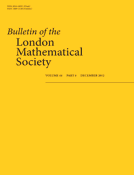
BULLETIN OF THE LONDON MATHEMATICAL SOCIETY
Cultivating Knowledge and Innovation in MathematicsThe BULLETIN OF THE LONDON MATHEMATICAL SOCIETY, published by Wiley, is a distinguished journal that serves as a vital resource in the field of mathematics. With its ISSN 0024-6093 and E-ISSN 1469-2120, this journal has consistently provided a platform for innovative research and scholarly discourse since its inception in 1969. Recognized for its quality, it currently holds an impressive Q1 ranking in the mathematics category, a testament to its significance in disseminating influential findings and trends in the mathematical sciences. Researchers and practitioners can rely on the BULLETIN for its comprehensive coverage of both theoretical and applied mathematics, which caters to a diverse audience ranging from professionals to students alike. Though it does not currently offer Open Access options, its articles can be accessed through institutional subscriptions, ensuring that significant works reach the academic community effectively. With contributions that span over five decades, the journal continues to shape mathematical research and inspire future advancements in the discipline.

Eurasian Mathematical Journal
Fostering Scholarly Exchange in Mathematics.Welcome to the Eurasian Mathematical Journal, a prominent platform dedicated to advancing the field of mathematics, particularly in its miscellaneous applications. Published by the esteemed L N Gumilyov Eurasian National University in Kazakhstan, this journal has been serving the academic community since 2014. With an ISSN of 2077-9879, it has successfully carved its niche within the mathematical landscape, presently ranked Q2 and placing in the 64th percentile among general mathematics publications in Scopus. The journal aims to foster scholarly exchange through high-quality research articles, reviews, and theoretical advancements that enhance understanding and application of mathematical concepts. By prioritizing open accessibility and a rigorous peer-review process, the Eurasian Mathematical Journal contributes significantly to both theoretical exploration and practical innovation, making it an essential resource for researchers, professionals, and students alike.

MICHIGAN MATHEMATICAL JOURNAL
Advancing Mathematical Frontiers with Rigorous ResearchThe MICHIGAN MATHEMATICAL JOURNAL is a prestigious and influential publication in the field of mathematics, founded by the University of Michigan. With an ISSN of 0026-2285 and an E-ISSN of 1945-2365, this journal is recognized for its high-quality research and has achieved a commendable Q1 ranking in the category of Mathematics (miscellaneous) as of 2023. Published by the esteemed Michigan Mathematical Journal, it provides a platform for the dissemination of innovative mathematical theories and findings, playing a crucial role in advancing knowledge and scholarship within the mathematical community. With coverage spanning from 1996 to 2024, the journal emphasizes rigorous theoretical development and fosters collaboration among researchers, professionals, and students alike. While not an open-access journal, its contributions are invaluable for those looking to stay abreast of cutting-edge mathematical research.

Milan Journal of Mathematics
Exploring the depths of mathematical innovation.Milan Journal of Mathematics is a prestigious academic publication dedicated to advancing the field of mathematics, particularly in the miscellaneous areas of the discipline. Published by SPRINGER BASEL AG in Switzerland, this journal has established a strong impact in the academic community, noted for its Q1 ranking in Mathematics and achieving a commendable 80th percentile in the Scopus rankings. With an ISSN of 1424-9286 and E-ISSN 1424-9294, the journal serves as a crucial platform for researchers and scholars to disseminate their findings and engage with cutting-edge mathematical theories and applications. Although not an Open Access publication, it provides valuable insights and rigorous academic discourse for professionals, researchers, and students alike, fostering a rich environment for knowledge exchange and innovation in mathematics.

TRANSACTIONS OF THE AMERICAN MATHEMATICAL SOCIETY
Pioneering Research in Applied and Theoretical MathematicsTRANSACTIONS OF THE AMERICAN MATHEMATICAL SOCIETY, published by the American Mathematical Society, is a premier journal in the field of mathematics that has been contributing to the advancement of mathematical knowledge since 1900. With an ISSN of 0002-9947 and an E-ISSN of 1088-6850, this journal holds a prestigious position in the academic landscape, evidenced by its Q1 rankings in both Applied Mathematics and Miscellaneous Mathematics categories as of 2023. With a Scopus ranking of #97 in General Mathematics and a percentile standing of 75th, the journal is recognized for its rigorous peer-review process and the quality of the research it publishes. Though it does not currently offer open access options, it essentially serves as a vital resource for researchers, professionals, and students seeking critical insights and developments in mathematical theory and applications. The Transactions aim to publish high-quality research articles that foster the exchange and dissemination of ideas, supporting the growth of both theoretical and applied mathematics within the global scholarly community.
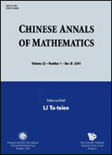
CHINESE ANNALS OF MATHEMATICS SERIES B
Empowering Researchers through Diverse Mathematical DiscoursesCHINESE ANNALS OF MATHEMATICS SERIES B, published by Shanghai Scientific Technology Literature Publishing House, is a prominent journal dedicated to fostering research and development in the field of mathematics. With an ISSN of 0252-9599 and an E-ISSN of 1860-6261, this journal provides a platform for the dissemination of innovative mathematical theories and methodologies. As of 2023, it is categorized within the Q4 quartile in *Applied Mathematics* and has achieved a commendable Q3 rank in *Mathematics (miscellaneous)*, emphasizing its growing influence in academia. Despite not being an open-access publication, it serves as a valuable resource for researchers, professionals, and students seeking to explore diverse mathematical topics, particularly from a unique regional perspective. The journal's extensive publication history—from 1980 and continuing to 2024—demonstrates a longstanding commitment to advancing mathematical knowledge and providing insights into various disciplines related to mathematics.
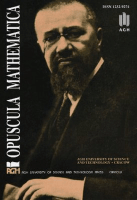
Opuscula Mathematica
Elevating Mathematical Discourse GloballyOpuscula Mathematica is an esteemed open-access journal published by AGH University of Science & Technology Press in Poland, specializing in the field of mathematics. Since its inception, it has provided a collaborative platform for researchers and scholars to share innovative mathematical insights and solutions, expanding its reach globally. With an impressive Q2 ranking in the realm of miscellaneous mathematics for 2023 and a notable Scopus ranking of Rank #139/399, it stands as a significant conduit for researchers seeking to publish high-quality, peer-reviewed articles. The journal has embraced open-access principles since 2004, ensuring that advancements in mathematical research are accessible to all. By publishing original research, reviews, and scholarly notes, Opuscula Mathematica plays a pivotal role in enhancing the visibility of vital mathematical discoveries and fostering academic discourse. Its convergence years from 2012 to 2024 highlight the journal's commitment to ongoing relevance and evolution in a dynamic research landscape.
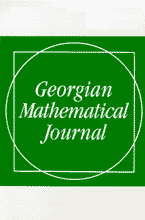
Georgian Mathematical Journal
Pioneering insights in diverse mathematical domains.Georgian Mathematical Journal, published by Walter de Gruyter GmbH, is a prestigious academic journal dedicated to the field of mathematics, particularly in its multifaceted applications and theoretical explorations. With an ISSN of 1072-947X and an E-ISSN of 1572-9176, this journal is indexed within notable databases and holds a strong position as evidenced by its Q2 ranking in the Mathematics (miscellaneous) category as of 2023 and a ranking of #140 out of 399 in the general mathematics Scopus category, placing it in the 65th percentile for research visibility. Since its inception in 1994, the journal has continued to evolve, aiming to foster innovative research and scholarly communication among mathematicians worldwide. Although it does not offer Open Access, the journal’s commitment to quality and rigor ensures that published works are of high relevance, appealing to researchers, educators, and students who are dedicated to advancing mathematical knowledge across diverse domains.
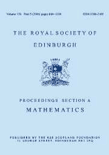
PROCEEDINGS OF THE ROYAL SOCIETY OF EDINBURGH SECTION A-MATHEMATICS
Connecting Ideas, Inspiring DiscoveriesPROCEEDINGS OF THE ROYAL SOCIETY OF EDINBURGH SECTION A-MATHEMATICS is a prestigious journal published by Cambridge University Press, focusing on high-quality research in the field of mathematics. Established in 1975, this journal has carved a niche in the academic community, evidenced by its categorization in the Q1 quartile for Mathematics (miscellaneous) in 2023 and a commendable Scopus rank of #59 out of 399 in General Mathematics, positioning it within the 85th percentile among its peers. The journal serves as a platform for disseminating innovative mathematical theories and methodologies, making it an essential resource for researchers, professionals, and students alike. Though not currently an open-access publication, it offers various access options catering to a broad audience. With a publication timeline extending through to 2024, PROCEEDINGS OF THE ROYAL SOCIETY OF EDINBURGH SECTION A-MATHEMATICS remains committed to advancing mathematical knowledge and fostering a scholarly environment conducive to scientific inquiry and collaboration.